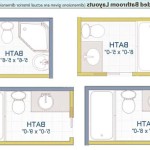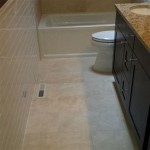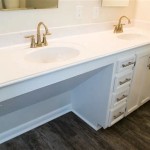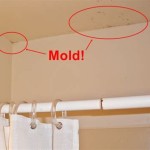How Long Will A Bathroom Last?
The longevity of a bathroom is a complex question with no single definitive answer. Several factors contribute to the lifespan of a bathroom, including the quality of materials used, frequency of use, maintenance practices, and the presence of inherent design flaws. Understanding these variables is crucial for homeowners planning a renovation or simply aiming to maximize the lifespan of their existing bathroom.
Bathrooms, subjected to high humidity, fluctuating temperatures, and frequent water exposure, are particularly vulnerable to wear and tear. Unlike other rooms in a house, bathrooms experience constant moisture, which can lead to mold growth, structural damage, and aesthetic degradation over time. Therefore, the expected lifespan of a bathroom is often shorter than that of a living room, bedroom, or dining room.
While some aspects of a bathroom may require earlier attention, such as paint or caulk, the major components can last for several decades if properly cared for. The following provides a detailed look at the factors influencing bathroom lifespan, key components and their individual longevities, and proactive measures to extend the life of the space.
Material Quality and Installation
The quality of materials used in a bathroom directly impacts its overall lifespan. Investing in durable, water-resistant materials is crucial for long-term success. For example, porcelain or ceramic tiles are typically more resistant to moisture and wear than cheaper alternatives like vinyl or laminate. Similarly, solid-surface countertops are less susceptible to staining and damage than laminate countertops.
Furthermore, the quality of installation plays a critical role. Improper installation can lead to a variety of problems, including leaks, cracks, and premature failure of components. For instance, poorly installed tile can crack or become loose, allowing water to seep behind the tile and damage the subfloor. Similarly, inadequately sealed plumbing fixtures can lead to water damage and mold growth.
Professional installation, while more expensive upfront, can save money in the long run by preventing costly repairs and extending the life of the bathroom. Proper planning and meticulous execution are essential for ensuring the longevity and functionality of a bathroom.
Choosing high-quality materials also impacts the aesthetic appeal of the bathroom over time. Durable materials tend to maintain their appearance longer, resisting fading, staining, and wear. This can significantly extend the time between necessary renovations, contributing to long-term cost savings and reducing the disruption of home life.
Consider the long-term impact of material choices. While a cheaper option might seem appealing initially, the need for more frequent replacements and repairs can quickly outweigh the initial savings. Invest in materials that are not only aesthetically pleasing but also built to withstand the rigors of a bathroom environment.
Usage Frequency and Maintenance
The frequency of bathroom usage directly correlates with its rate of wear and tear. A master bathroom used multiple times daily by several individuals will naturally experience more stress than a guest bathroom used only occasionally. Higher usage translates to more frequent cleaning, exposure to moisture, and wear on fixtures and surfaces.
Regular maintenance is essential for maximizing the lifespan of a bathroom. This includes routine cleaning to prevent the buildup of mold and mildew, addressing minor repairs promptly, and inspecting plumbing fixtures for leaks. Neglecting maintenance can lead to more significant problems that require costly repairs or even a complete renovation.
Simple maintenance tasks, such as recaulking around tubs and showers, resealing grout lines, and cleaning showerheads, can significantly extend the life of these components. Promptly addressing leaks from faucets or toilets can prevent water damage and mold growth, which can compromise the structural integrity of the bathroom.
The type of cleaning products used also impacts the durability of bathroom surfaces. Harsh chemicals can damage certain materials, leading to discoloration, etching, or premature wear. Using gentle, pH-neutral cleaners specifically designed for bathroom surfaces can help preserve their appearance and longevity.
Proper ventilation is also an important aspect of bathroom maintenance. Adequate ventilation helps remove moisture from the air, reducing the risk of mold and mildew growth. Ensuring that the bathroom fan is functioning properly and using it during and after showers or baths can significantly improve the air quality and extend the life of the bathroom.
Key Bathroom Components and Their Lifespans
Different components within a bathroom have varying lifespans. Understanding the expected longevity of each component is essential for anticipating future maintenance needs and planning renovations effectively.
Toilets: A well-maintained toilet can last for 20 to 30 years. However, internal components such as flappers and fill valves may require replacement more frequently, typically every few years. Signs of a failing toilet include frequent clogs, leaks, and inefficient flushing. Upgrading to a low-flow toilet can conserve water and reduce utility bills.
Bathtubs and Showers: The lifespan of a bathtub or shower depends on the material and the quality of installation. Acrylic or fiberglass tubs and showers can last for 10 to 15 years, while cast iron or steel tubs with enamel coatings can last for 20 to 30 years or more. Regular cleaning and maintenance, such as repairing chips or cracks in the enamel, can extend their lifespan. Recaulking around the edges is crucial to prevent water damage.
Sinks and Faucets: Sinks made from porcelain or ceramic are highly durable and can last for 20 to 30 years or more. Faucets, on the other hand, typically have a shorter lifespan, ranging from 10 to 15 years. Leaks, reduced water pressure, and difficulty adjusting the temperature are common signs that a faucet needs replacement. Upgrading to a water-efficient faucet can save water and lower utility bills.
Countertops: Countertops can have varying lifespans depending on the material. Laminate countertops typically last for 5 to 10 years, while solid-surface countertops can last for 15 to 20 years or more. Natural stone countertops, such as granite or marble, can last for several decades with proper sealing and maintenance. Choosing a durable, water-resistant material is essential for extending the life of the countertop.
Flooring: Bathroom flooring needs to be water-resistant and durable. Tile, particularly porcelain or ceramic tile, is a popular choice due to its durability and water resistance, and can last for 20 to 30 years or more. Vinyl flooring can last for 10 to 20 years, while laminate flooring is less suitable for bathrooms due to its susceptibility to water damage. Proper installation and sealing are crucial for preventing water damage and extending the life of the flooring.
Ventilation Fan: A bathroom ventilation fan typically lasts for 10 years. However, its lifespan can be shortened by dust and debris buildup. Regular cleaning and maintenance can help extend its life. A properly functioning ventilation fan is essential for removing moisture and preventing mold growth.
Plumbing: Plumbing pipes, if made of durable materials like copper or PEX, can last for several decades. However, older plumbing systems with galvanized steel pipes are prone to corrosion and may require replacement after 50 to 70 years. Regular inspections and prompt repairs of leaks can help extend the life of the plumbing system.
Lighting: Bathroom lighting fixtures can last for many years, especially LED fixtures, but the bulbs themselves will need replacement periodically. Regular cleaning of light fixtures can remove dust and debris, improving their performance and lifespan.
By understanding the expected lifespan of each bathroom component, homeowners can proactively plan for maintenance and renovations, ensuring the long-term functionality and aesthetic appeal of the space.
Ultimately, the lifespan of a bathroom is not solely determined by time but by a combination of factors that require attention and care. Proactive maintenance, mindful usage, and informed material choices can significantly extend the life of this vital space within a home.

How Often Should You Renovate Your Bathroom Rwc
/arc-anglerfish-arc2-prod-pmn.s3.amazonaws.com/public/57SYIGFNPFHP5CJFBDUV3E6PTM.jpg?strip=all)
Ask Jennifer Adams How Long Should That Bathroom Tile Last

How Long Does A Wetroom Last In Your Home Ccl Wetrooms

How Long Does A Toilet Last Designer Answers The Specialist

How Long Do Toilets Last 7 Signs You Need To Replace It Clover Services

How Long Should A Quality Toilet Last Nj Bathroom Remodeling Renovation

How Long Does An Average Toilet Last In A Home Sutton Brothers

5 Key Signs I Need To Replace Bathroom Faucets San Diego

Just How Long Does A Toilet Last Wyman Plumbing

Bathroom Renovation Step By Watara Homes
Related Posts







